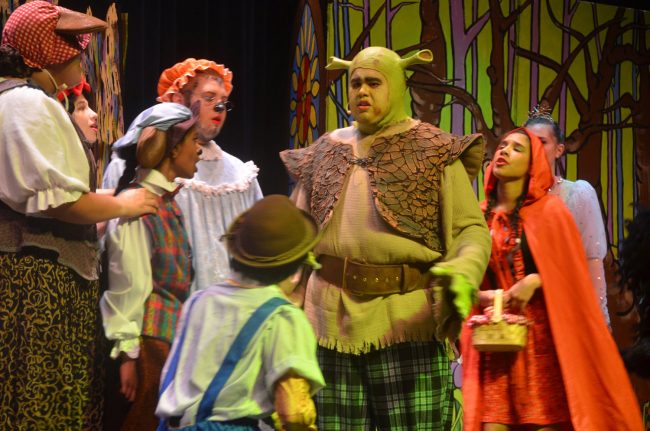
To book tickets for “Shrek” easily, go here.
“Once upon a time there was a little ogre named Shrek who lived with his parents in a bog by a tree.” A nasty place actually, but “ogres like nasty.” It doesn’t last: Shrek’s parents soon boot him out to make his way in a swamp of his own.
So begins “Shrek The Musical,” the Jeanine Tesori and David Lindsay-Abaire production that opened on Broadway 10 years ago and that opens at Matanzas High School’s Pirate Theater Wednesday evening for friends and family of the production, and Thursday through Saturday for the general public.
The musical doesn’t let up, with some 20 musical numbers—not counting minor transitions–a script that turns every familiar fairy tale on its head with one-liners, puns and send-ups grabbed from contemporary culture, and that running theme that should play right into the familiar terrain of 2018 America: differences matter, in the very best sense.
“The audience can draw its own conclusions about this but our students get to see it first hand,” says Noël Bethea, a drama teacher at Matanzas in her first year there, “about how they should celebrate their differences, they should celebrate their uniqueness, they should celebrate diversity, and that’s what I’m hoping to bring to the audience. There’s a tolerance that’s needed in our society.”
Or as the overcaffeinated Princess Fiona (Michelle Roy) tells Shrek at one point, “Maybe you shouldn’t judge people before you get to know them.” This to the ogre who’s been so judged all his life that he’s retreated to the corner of a swamp, preferring never to be bothered again. Of course, he was asking for it: to the audience’s delights, he is to be incessantly bothered from beginning to end as he is forced on a journey of, well, discovery—about himself and everyone and everything around him, starting with “A Big Bright Beautiful World.”
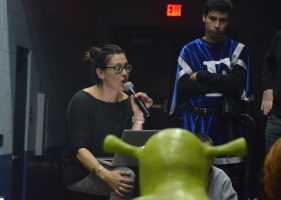
“It comes down to Noël,” DeZego said during a break in rehearsals last week. “She has let go of a lot of the things and created tentacles, bringing professional people in, and I said to her in the beginning, I said I would love to help you if you’re the type that wants to get professionals.” She did. Even if most of the production is made up of students: they’re fulfilling their roles like professionals.
Ask Jared Allen, the Matanzas percussion teacher leading the orchestra.

“The greatest challenge is that it’s just one musician to a part,” Allen says. “There’s only one trumpet player, there’s only one clarinet player, so they have to take the full responsibility of that part, and every part being there, there’s no sitting out and letting the clarinet or the guitar player next to you cover that part because you’re the only one. So it’s a lot of responsibility. They’re doing great with it. We’ve been very, very happy with the quality they’ve been bringing to it. They’ve put a lot of time in outside of rehearsals, practicing, learning their parts, and as we get them notes at the end of rehearsals, here are the things we need to tackle, they come back for the next rehearsal with that stuff fixed. They’ve taken a lot of responsibility and they’re doing phenomenal with it. I would hire any of these musicians in a professional pit. Absolutely. Absolutely.”
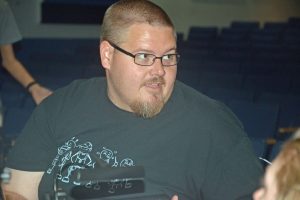
Plus he has musicians like 11th-grader Mario Saponaro, a keyboardist who looks just like Bruno Martelli, the keyboardist in the 1980 original production of “Fame,” and speaks with the same irreverent self-confidence: “I thought I could handle it,” Saponaro said, recalling his first look at the very challenging score—the very same score as that of the Broadway production. No going easy on kids here. “I like a challenge, and it’s more fun that way. Easy songs? It’s more enjoyable to be challenged.”
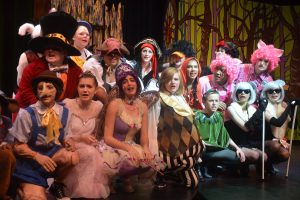
After Shrek’s parents kick out the green creature with trumpet ears and the inexplicable hint of an Irish accent when he turns 7, he finds his “big bright beautiful world” in a richly undrained swamp. But then a whole bunch of freaks invade it: the three little pigs, Peter Pan, the Big Bad Wolf, Humpty Dumpty, Pinocchio and the rest of the cast of every fairy tale you grew up on. (Pinocchio’s nose is the work of Matt Gasper, a Matanzas student who used a 3D printer for the job.) They’ve all been thrown out of their domains by evil Lord Farquaad, who threatens to kill them if they return. Always a loner, Shrek is none too happy to share his swamp. He ambles over to Farquaad’s garish estate (“Do you think he’s compensating for something?” Shrek asks in a voice as diminished as what it implies) and confronts him to get his swamp back.
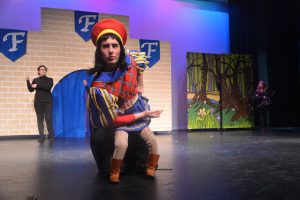
Farquaad makes a deal with Shrek: rescue me Princess Fiona from whatever dire tower she’s strung on, and you’ll get your swamp back. So develops the adventure of transformation between Shrek, his trusty Donkey (the exuberant Matthew Eaton) and Fiona in her various incarnations.
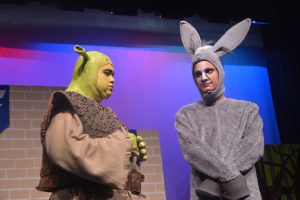
He likes the complexities of Shrek—and the connection he feels with the ogre. Soto remembers his rather swampish days in younger grades. “Definitely being called out a lot, being different, like being different from most people,” he says. “Not so now, because after I joined theater it’s a very tight-knit group and everybody’s really been with each other, but beforehand, like middle school and all that stuff…” his voice trails off: not the happiest memories.
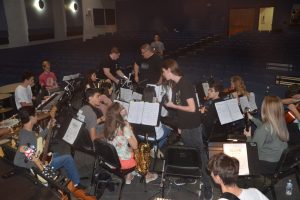
“I love the message of not judging somebody by how they look, and treating people with dignity and respect based on their differences,” she says. “ That’s why I love it. When you see ‘Freak Flag’,” one of the numbers in the show, “what makes us different makes us stronger, I keep telling that to the cast, that’s our motto, what makes us different makes us stronger as a department, as a cast and crew, and pit, all these differences create this wonderful utopian society that’s, you know, Duloc. Unfortunately Lord Farquaad wants to take that away, he wants to make everyone the same.”
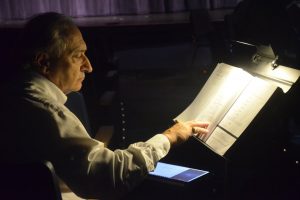
“Shrek” might as well be part of Bethea’s own journey home of sorts: She’d gone to Catholic school in Daytona Beach—her favorite role was there, as Nancy, playing opposite her brother in a production of “Oliver”—and started her teaching career at Flagler Palm Coast High School in her 20s, teaching dance, English and acting from 1995 to 1999. She married and moved away as her husband was in the Coast Guard, traveling for almost 20 years. “So I’m coming back home, and I knew I wanted to come back to Flagler County,” she says.
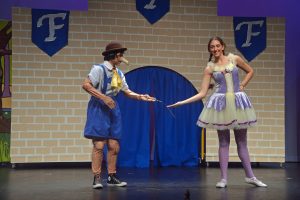
How cool? “I’ve worked with and directed young actors for a long time,” Bethea said just before the first full dress rehearsal began on Saturday as she sat toward the top of the house, in semi-darkness, “and all the worrying that I put into it and the stress, that night, when we open to a house that’s filled with people, it really—it’s something magical, and every time it moves me. Because this is a lot of work, and I’m always like—Oh, I don’t want to do this anymore. But you know what? That night, that magic, it just fills your soul. It’s a beautiful thing.”
![]()
Matanzas High School presents “Shrek The Musical,” directed by Noël Bethea, with music by Jeanine Tesori and book and lyrics by David Lindsay-Abaire, based on the original book by William Steig, and with musical direction by Jens Oliva, featuring Rafael Soto, Michelle Roy, Matthew Eaton, Michael Sheehan, and Matanzas’s drama students, live music accompanying 19 songs performed by Matanzas High and Flagler Youth Orchestra musicians under the direction of Jared Allen. The April 25 show at 7 p.m. is for friends and family members, actual opening night is April 26 for the 7 p.m. show. April 27 and 28 also have 7 p.m. shows, plus a 2 p.m. matinee on April 28. Tickets are $11. Click here for tickets.





























Leave a Reply